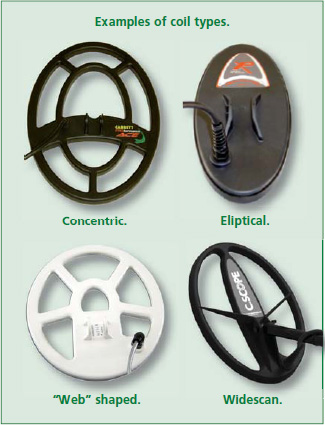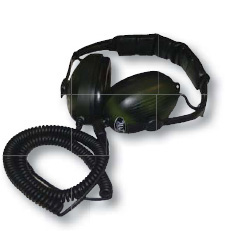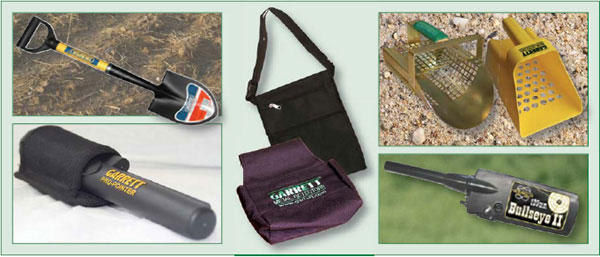Detecting Accessories
Search Coils
Metal detector search coils come in a variety of shapes and sizes from just a few inches across to a staggering 18 inches or more! Some are concentric (polo coils), some are even web shaped and several have an ovoid or “coffee bean” configuration. Several makes of detectors offer the ability to interchange from one type of coil to another.

Smaller coils tend to have better pinpointing capabilities and are easier to use on rough ground or on sites that are overgrown and where manoeuvrability is a problem.
Larger coils usually offer greater depth capabilities and can cover more ground in a shorter space of time. These coils quite often add considerable weight to a machine and are more suited to flatter ground surfaces.
Concentric coils put out a search field resembling an inverted cone. Size for size they usually go deeper and are often better when searching junk-infested sites. Double-D or wide scan coils, with their cylindrical search fields, normally provide better and faster ground coverage.
It is worth checking, before you make a purchase, that the type of detector you wish to buy can use interchangeable coils.
Headphones
Although most metal detectors have built-in speakers the use of headphones is recommended. These help to exclude outside noise that can mask any faint signals.
You will find that most metal detectors will generally accept any type of headphone from the portable CD player type right up to the largest size available. Most dealers also stock more expensive headphones that offer a “signal boost” facility. Again, it all boils down to what you are willing to spend. Not only do headphones reduce battery consumption they also help to keep your ears warm in the winter! Headphones are available now in standard curly cable format or cable free.

Digging Implements
It can’t be stressed enough that the need for a good quality digging tool is essential in this hobby. Whether you opt for a simple trowel or a foot-assisted spade, you would be well advised to buy the strongest that you can afford. A cheap “tinny” trowel may be ideal for garden use but it won’t last five minutes in the field. This is particularly important if you intend to detect in an area where the soil is of the heavy clay type. I have seen, and personally experienced, several occasions when digging implements have bent or broken completely while in use. This can really be a nuisance when a promising target has been located but the finder can’t get to it due to implement failure. It may also be advisable to keep a spare tool somewhere near to hand – as I do.

Coin Probes
These are small “metal detectors” that are basically not much bigger than a pen and cigarette packet and fit easily into one’s pocket. They are used only when a small target proves difficult to locate in a hole. The end of the probe is swept around the inside of the hole and a small LED lights up when it comes into close proximity with the coin or artefact. In the last few years probes have really come into their own being both improved in build quality and target response, having already proven themselves as very useful additions to standard kit.
Finds Bags
The worst thing you can do to a precious find is put it straight into your pocket along with all the other odds and ends that you have extracted from the ground. This will probably do more damage than centuries of agriculture and corrosion could ever do! Most detectorists wear waistband type pouches to carry any “good” finds. It is also recommended to carry a selection of self-sealing polythene bags in order to keep delicate finds separate from one another.
GPS Equipment
Another development that is now widely available in the 21st century is GPS (Global Positioning System) equipment. These can be purchased as individual units or even appear as a standard feature or available App for many mobile phones.
The importance of GPS is the accurate plotting of single finds or spreads of finds. Depending on which application is used accuracy will vary, but in almost every case its definition is suitable for recording purposes. Some phones have the ability to monitor via GPS the individual as they walk and superimpose this data onto Google Earth. This is incredibly useful as you can frequently assess the ground and areas that you have searched. Undoubtedly future developments will refine the ability of such functions in terms of accuracy and data definition.
Basic Kit
Apart from the above, basic kit should include warm or waterproof clothing (depending on weather conditions), sturdy boots or Wellingtons, gloves, water, First Aid (sticking plasters), note-pad and pencil and insect repellent. Also, it’s a good idea to either inform somebody where you are going or take along your mobile phone.